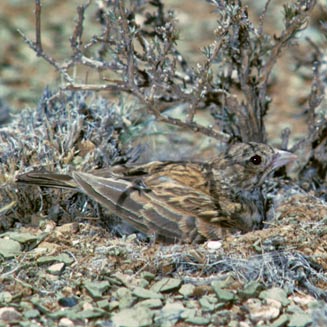|
Eremopterix australis
(Black-eared sparrowlark, Blackeared finchlark)
Swartoorlewerik [Afrikaans]; kafferleeuwerik [Dutch];
Moinelette à oreillons noirs [French]; Schwarzwangenlerche [German];
Cotovia-pardal-preta [Portuguese]
Life
> Eukaryotes >
Opisthokonta
> Metazoa (animals) >
Bilateria >
Deuterostomia > Chordata >
Craniata > Vertebrata (vertebrates) > Gnathostomata (jawed
vertebrates) > Teleostomi (teleost fish) > Osteichthyes (bony fish) > Class:
Sarcopterygii (lobe-finned
fish) > Stegocephalia (terrestrial
vertebrates) > Tetrapoda
(four-legged vertebrates) > Reptiliomorpha > Amniota >
Reptilia (reptiles) >
Romeriida > Diapsida > Archosauromorpha > Archosauria >
Dinosauria
(dinosaurs) > Saurischia > Theropoda (bipedal predatory dinosaurs) >
Coelurosauria > Maniraptora > Aves
(birds) > Order: Passeriformes
> Family: Alaudidae > Genus: Eremopterix
 |
|
|
Black-eared sparrowlark female sitting on nest.
[photo Peter Steyn ©] |
|
Distribution and habitat
Endemic to South Africa, with the bulk of its population in
the Northern Cape Karoo, extending north-east to Namibia. It generally prefers
sparse dwarf shrubland (especially Karoo scrub) and grassland, especially on red
sand or stony soils.
|
 |
|
Distribution of Black-eared sparrowlark in southern Africa,
based on statistical smoothing of the records from first SA Bird Atlas
Project (©
Animal Demography unit, University of
Cape Town; smoothing by Birgit Erni and Francesca Little). Colours range
from dark blue (most common) through to yellow (least common).
See here for the latest distribution
from the SABAP2. |
Food
It mainly eats seeds supplemented with invertebrates, doing
most of its foraging in flocks on the ground, plucking food items from soil and
the bases of plants. The following food items have been recorded
in its diet:
- Seeds
- grasses
- Stipagrostis
- Schmidtia
- Aristida
- Enneapogon
- forbs
- Giseckia
- Chenopodium
- Hypertelis
- Hermannia
- Psilocaulon
- Fruit of honey-thorns (Lycium)
- Arthropods
- Hodotermes mossambicus (Northern harvester termites)
- ants
- leaf-hoppers (Hemiptera)
- Coleoptera
(beetles)
Breeding
- The nest (see image above) is built solely by the female in about 4-5
days, consisting of cup built of fine grass, feathery awns and rootlets. It
is typically placed on a foundation of twigs, in an excavated hollow against
a shrub or grass tuft, with the rim decorated with the webs of buckspoor
spiders (Seothyra).
- It can lay its eggs at any time of year, usually in the weeks after a
period of heavy rainfall.
- It lays 1-4 eggs, which are incubated by both sexes for about 8-11 days.
- The young chicks are brooded by both parents in the heat of the day, and
are fed exclusively on invertebrates. When they reach about 7-10 days of age
(later if it had been raining), the adults coax the young away from the nest
with feeding calls, before they can even fly. After a few days they are
capable of running and hiding from predators, only learning to fly when they
are 15-20 days old.
Threats
Not threatened.
References
-
Hockey PAR, Dean WRJ and Ryan PG 2005. Roberts
- Birds of southern Africa, VIIth ed. The Trustees of the John Voelcker
Bird Book Fund, Cape Town.
|
